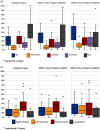KL2 mentored career development programs at clinical and translational science award hubs: Practices and outcomes
- PMID: 32257410
- PMCID: PMC7103475
- DOI: 10.1017/cts.2019.424
KL2 mentored career development programs at clinical and translational science award hubs: Practices and outcomes
Abstract
Introduction: NIH Clinical and Translational Science Awards (CTSAs) include KL2 mentored career development awards for faculty commencing clinical and translational research. A survey of KL2 leaders revealed program practices, curricular elements and compelling data about scholar characteristics and outcomes.
Methods: We conducted a literature review, framed the survey construct, and obtained input from across the CTSA consortium. A REDCap survey was emailed in fall 2016 to 61 active programs.
Results: Fifty-five programs (90.2%) responded. Respondents had been funded from 3 to 11 years, including 22 "mature" hubs funded for ≥8 years. Program cohort sizes were 56% "small", 22% "medium", and 22% "large." Hubs offer extensive competency-aligned training opportunities relevant to clinical and translational research, including graduate degrees, mentorship, and grant-writing. Seventy-two percent of hubs report parallel "KL2-equivalent" career development programs. All hubs share their training and facilitate intermingling with other early stage investigators. A total of 1,517 KL2 scholars were funded. KL2 awardees are diverse in their disciplines, research projects, and representation; 54% are female and 12% self-identified as underrepresented in biomedical research. Eighty-seven percent of scholars have 2-3 mentors and are currently supported for 2-3 years. Seventy-eight percent of alumni remain at CTSA institutions in translational science. The most common form of NIH support following scholars' KL2 award is an individual career development award.
Conclusions: The KL2 is a unique career development award, shaped by competency-aligned training opportunities and interdisciplinary mentorship that inform translational research pathways. Tracking both traditional and novel outcomes of KL2 scholars is essential to capture their career trajectories and impact on health.
Keywords: Mentored career development; clinical and translational research workforce; clinical and translational science awards; survey outcomes; training curriculum.
© The Association for Clinical and Translational Science 2019.
Figures







Similar articles
-
Improving clinical and translational research training: a qualitative evaluation of the Atlanta Clinical and Translational Science Institute KL2-mentored research scholars program.J Investig Med. 2017 Jan;65(1):23-31. doi: 10.1136/jim-2016-000143. Epub 2016 Sep 2. J Investig Med. 2017. PMID: 27591319 Free PMC article.
-
Transition to Independence: Characteristics and Outcomes of Mentored Career Development (KL2) Scholars at Clinical and Translational Science Award Institutions.Acad Med. 2017 Apr;92(4):556-562. doi: 10.1097/ACM.0000000000001473. Acad Med. 2017. PMID: 28351069 Free PMC article.
-
Scholarly Productivity Evaluation of KL2 Scholars Using Bibliometrics and Federal Follow-on Funding: Cross-Institution Study.J Med Internet Res. 2021 Sep 29;23(9):e29239. doi: 10.2196/29239. J Med Internet Res. 2021. PMID: 34586077 Free PMC article.
-
Training and cultivating the translational science workforce: Responses of Clinical and Translational Science Awards program hubs to the COVID-19 pandemic.Clin Transl Sci. 2023 Jan;16(1):43-49. doi: 10.1111/cts.13437. Epub 2022 Nov 29. Clin Transl Sci. 2023. PMID: 36448246 Free PMC article. Review.
-
Mentored career development awards for the development of surgeon-scientists.Surgery. 2021 Oct;170(4):1105-1111. doi: 10.1016/j.surg.2021.04.032. Epub 2021 Jun 13. Surgery. 2021. PMID: 34134897 Review.
Cited by
-
Building an institutional K awardee program at UC Davis through utilization of CTSA resources.J Clin Transl Sci. 2021 Aug 13;5(1):e171. doi: 10.1017/cts.2021.839. eCollection 2021. J Clin Transl Sci. 2021. PMID: 34733547 Free PMC article.
-
Mentoring up for early career investigators: Empowering mentees to proactively engage in their mentoring relationships.J Clin Transl Sci. 2024 Apr 22;8(1):e86. doi: 10.1017/cts.2024.524. eCollection 2024. J Clin Transl Sci. 2024. PMID: 38784110 Free PMC article.
-
The Virtual CTSA Visiting Scholar Program to Support Early-Stage Clinical and Translational Researchers: Implementation and Outcomes.Acad Med. 2022 Sep 1;97(9):1311-1316. doi: 10.1097/ACM.0000000000004645. Epub 2022 Mar 8. Acad Med. 2022. PMID: 35263302 Free PMC article.
-
KL2 scholars' perceptions of factors contributing to sustained translational science career success.J Clin Transl Sci. 2021 Dec 28;6(1):e34. doi: 10.1017/cts.2021.886. eCollection 2022. J Clin Transl Sci. 2021. PMID: 35433037 Free PMC article.
-
Clinical and translational science award T32/TL1 training programs: program goals and mentorship practices.J Clin Transl Sci. 2021 Dec 27;6(1):e13. doi: 10.1017/cts.2021.884. eCollection 2022. J Clin Transl Sci. 2021. PMID: 35211339 Free PMC article.
References
Grants and funding
LinkOut - more resources
Full Text Sources
Miscellaneous
